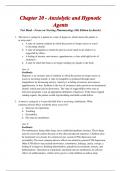Exam (elaborations)
Chapter 20 - Anxiolytic and Hypnotic Agents |Test Bank - Focus on Nursing Pharmacology (8th Edition by Karch)
- Course
- Institution
1. The nurse is caring for a patient in a state of hypnosis, which means the patient is in what state? a. A state of extreme sedation in which the person no longer senses or reacts to incoming stimuli. b. A state of tranquility in which the person can be made to do whatever is suggested by others...
[Show more]



